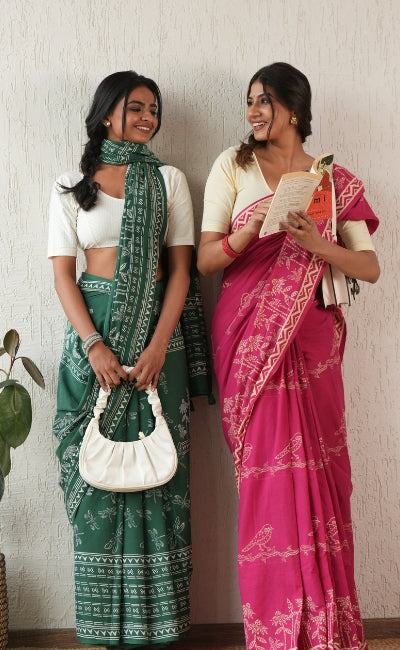Article: Where To Get The Best Mulmul Sarees?

Where To Get The Best Mulmul Sarees?
Mulmul Cotton Saree Online
Cotton is the fabric of choice for the vast majority of Indian women who drape themselves in sarees during the hotter months, and this is especially true for those who drape themselves in mulmul sarees.
In the heat of summer, this is a fast and efficient method for maintaining your cool. For those who are more used to wearing a salwar kameez, the cotton form of the garment will be more comfortable.
Because dark colours are able to quickly absorb heat, lighter colours are recommended for cooling purposes rather than darker ones.
What's The Latest Going On This Summer?
Pure handloom Mulmul sarees are available in a spectacular assortment of light and pastel colours in vivid tints that are both pleasant to the sight and comfortable to wear. It is said that the Mulmul fabric evokes recollections of silky and smooth sarees that one can wear all day and bask in the admiring glance of others while simultaneously savoring the beautiful feel of the garment itself.
These Jaipuri hand block printed mulmul sarees are a visual treat with their intricately matched floral borders, geometric flower designs, and occasionally large birds on the pallu or end piece in self-color.
Additionally, these mulmul sarees have a feeling of freshness and appeal to them.
It is as if a light summer breeze were flowing through the sand dunes of the Rajasthani desert. In addition, you can choose between an attachment made of handcrafted pure silk or a blouse made of matching Mulmul cotton.
When it comes to the marketplace, SootiSyahi is aware of the fluctuating demand for distinctive and attention-grabbing materials throughout the course of the year.
Why Cotton In Summers?
The sarees and the salwar kameez are two examples of traditional Indian clothing that feature a wide variety of styles and patterns. Cotton handlooms are outstanding examples of this diversity.
Handloom cottons have simple lattice weaves and tightly spaced yarn strands, making them ideal for the production of simple garments. Cotton has various advantages over other natural fibers when it comes to being used as a fabric for extended periods of time and on a daily basis.
It has a texture that is soft and silky, is light and airy, is sheer, and is kind on the skin. Cotton fabric is a great canvas for a wide variety of exotic arts and crafts.
Some examples are the art of Kalamkari or pen Batik, tie-and-dye Bandhani, the distinctive ikat of Pochampally, Sambalpur, or Rajkot, the Patachitra, and other such practises. Mulmul cotton sarees online are a smooth and densely woven clothing that naturally absorbs moisture and has a silky texture.
To create lovely clothing, such as the soft Bengal Tants, Jamdani cottons with their hand-woven patterns, the transparent Muslin Dhaka cotton, the Sambalpuri ikats, and the Bomkais with captivating themes, cotton is an excellent medium. Jamdani Cottons, with their hand-woven patterns and zari, are among the most popular cotton clothing in India.
Besides,
- The physical properties of cotton, which include being a comfortable and soft fabric material, as well as one that can absorb moisture when the weather is hot and insulate heat when the weather is cold, are valued.
- Cotton emerges from this procedure with increased tensile strength and luster, in addition to increased resistance to wear.
- This fabric has a good affinity for most colour dyes, so it will look wonderful with block designs as well as any other kind of print you choose to use.
- It has an exceptionally high capacity for absorbing colour dyes, which assures that the fabric will last for a long time and retain its brilliant colour.
- It can be adorned with zardozi, sequins, mirror work, kundan work, beads, and a wide variety of other adornments, and the possibilities for doing so are virtually limitless.
Mulmul Sarees And Summer Go Together Like Peanut Butter And Jelly
The wearing of this mulmul sarees is not only required for the season, but it also serves as a means to demonstrate your youthfulness while allowing you to keep your cool in the scorching heat.




